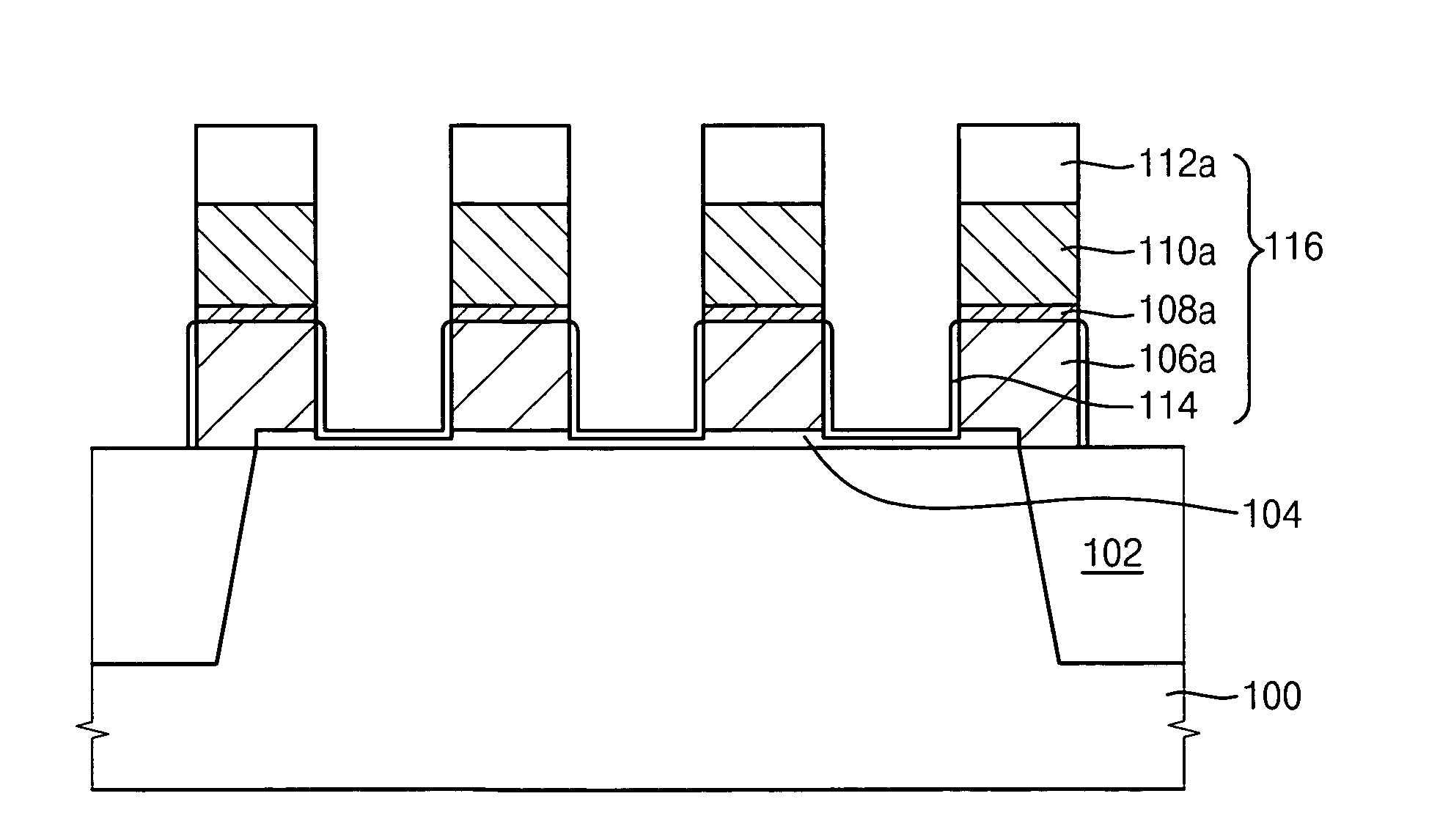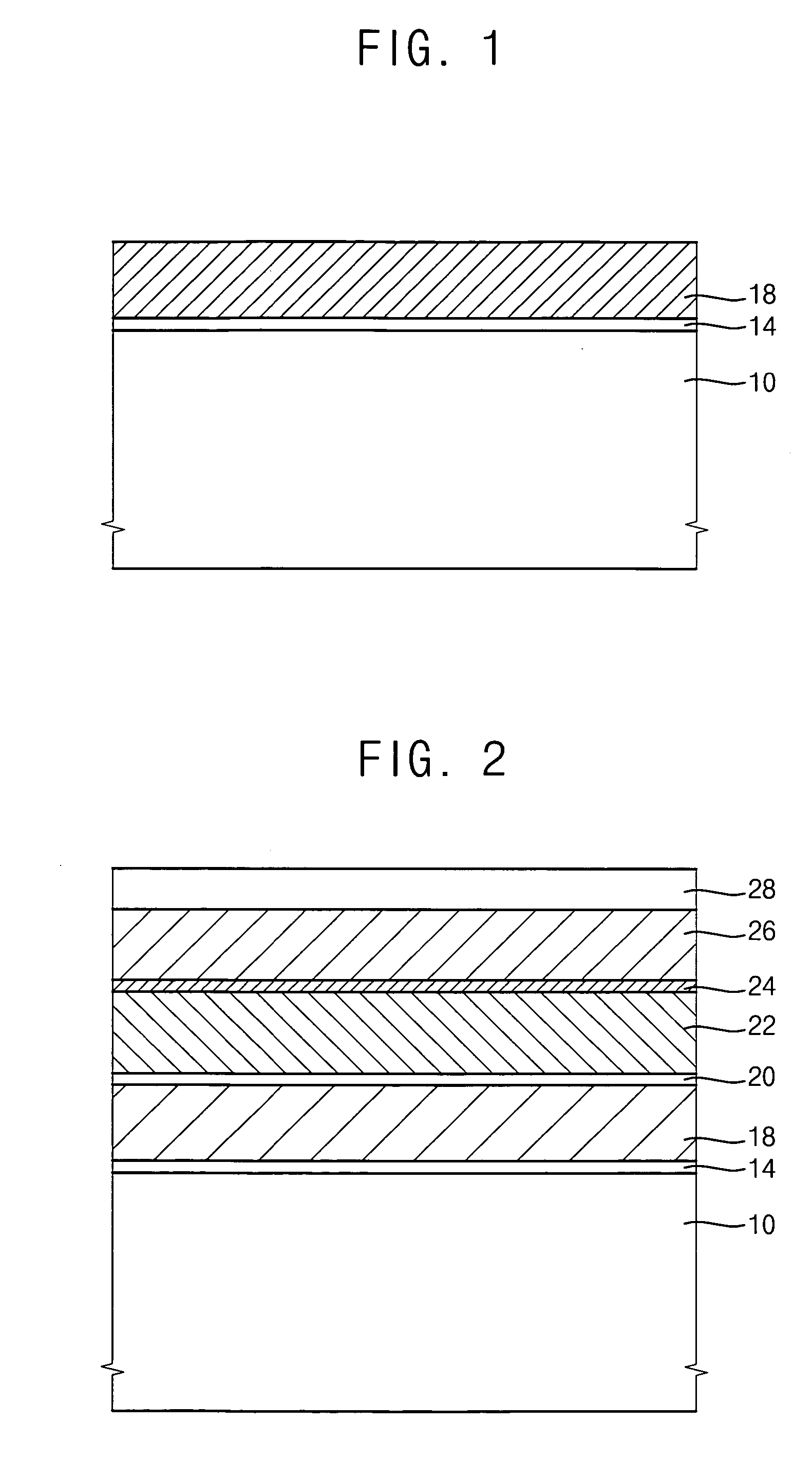Method of forming a gate of a semiconductor device
a technology of semiconductor devices and gate oxides, applied in the field of semiconductor devices, can solve the problems of gate oxide layers having a greater thickness than desired, etching damage may be generated at surface portions of substrates, and the structure of semiconductor devices is complicated and multi-layered, so as to achieve the effect of improving the yield of semiconductor devices
- Summary
- Abstract
- Description
- Claims
- Application Information
AI Technical Summary
Benefits of technology
Problems solved by technology
Method used
Image
Examples
embodiment 1
[0033]FIGS. 1 to 6 are cross sectional views illustrating a method of manufacturing a non-volatile memory device in accordance with a first exemplary embodiment of the present invention.
[0034]Referring to FIG. 1, an isolation region (not shown) of a silicon substrate 10 is selectively etched to form an isolation trench at a surface portion of the silicon substrate 10. Then, an insulation layer is formed in the trench and on the silicon substrate 10. The insulation layer is polished by a chemical mechanical polishing (CMP) process to form an isolation pattern (not shown) in the trench. An active region and the isolation region of the silicon substrate 10 are defined by the CMP process.
[0035]A tunnel oxide layer 14 is grown from exposed portions of the silicon substrate 10, which are the active region.
[0036]A first polysilicon layer (not shown) doped with impurities is formed on the tunnel oxide layer 14. The first polysilicon layer is used as a floating gate electrode by a subsequent...
embodiment 2
[0072]A method of forming a non-volatile memory device in Embodiment 2 is substantially identical to that in Embodiment 1 except for performing a hydrogen reduction process in a separate chamber. Thus, an oxidation process and the hydrogen reduction process are predominantly illustrated.
[0073]Processes substantially identical to those illustrated with reference to FIGS. 1 to 3 are carried out to form a first preliminary gate structure on a semiconductor substrate.
[0074]The oxidation process using oxygen radicals is then performed in a first chamber to convert the first preliminary gate structure into a second preliminary gate structure. The semiconductor substrate is loaded into a second chamber 56 with vacuum being continuously provided. The hydrogen reduction process is then carried out in the second chamber 56.
[0075]FIG. 10 is a flow chart illustrating a primary oxidation process and a hydrogen reduction process in accordance with the second exemplary embodiment of the present in...
embodiment 3
[0092]FIGS. 12 and 13 are cross sectional views illustrating a method of manufacturing a field effect transistor in accordance with Embodiment 3 of the present invention.
[0093]Referring to FIG. 12, an isolation layer 102 is formed in a trench of a silicon substrate 100 by a trench isolation process to define an active region and a field region of the semiconductor substrate 100. An exposed portion of the silicon substrate 100 is thermally treated to form a gate oxide layer on the active region.
[0094]A polysilicon layer doped with N-type impurities or P-type impurities is formed on the gate oxide layer 104. In this embodiment, the polysilicon layer is utilized as a gate electrode. Particularly, when an N-type transistor is to be formed, the polysilicon layer doped with N-type impurities is formed on the gate oxide layer 104. On the contrary, when a P-type transistor is to be formed, the polysilicon layer doped with P-type impurities is formed on the gate oxide layer 104. In a dynamic...
PUM
 Login to View More
Login to View More Abstract
Description
Claims
Application Information
 Login to View More
Login to View More - R&D Engineer
- R&D Manager
- IP Professional
- Industry Leading Data Capabilities
- Powerful AI technology
- Patent DNA Extraction
Browse by: Latest US Patents, China's latest patents, Technical Efficacy Thesaurus, Application Domain, Technology Topic, Popular Technical Reports.
© 2024 PatSnap. All rights reserved.Legal|Privacy policy|Modern Slavery Act Transparency Statement|Sitemap|About US| Contact US: help@patsnap.com










